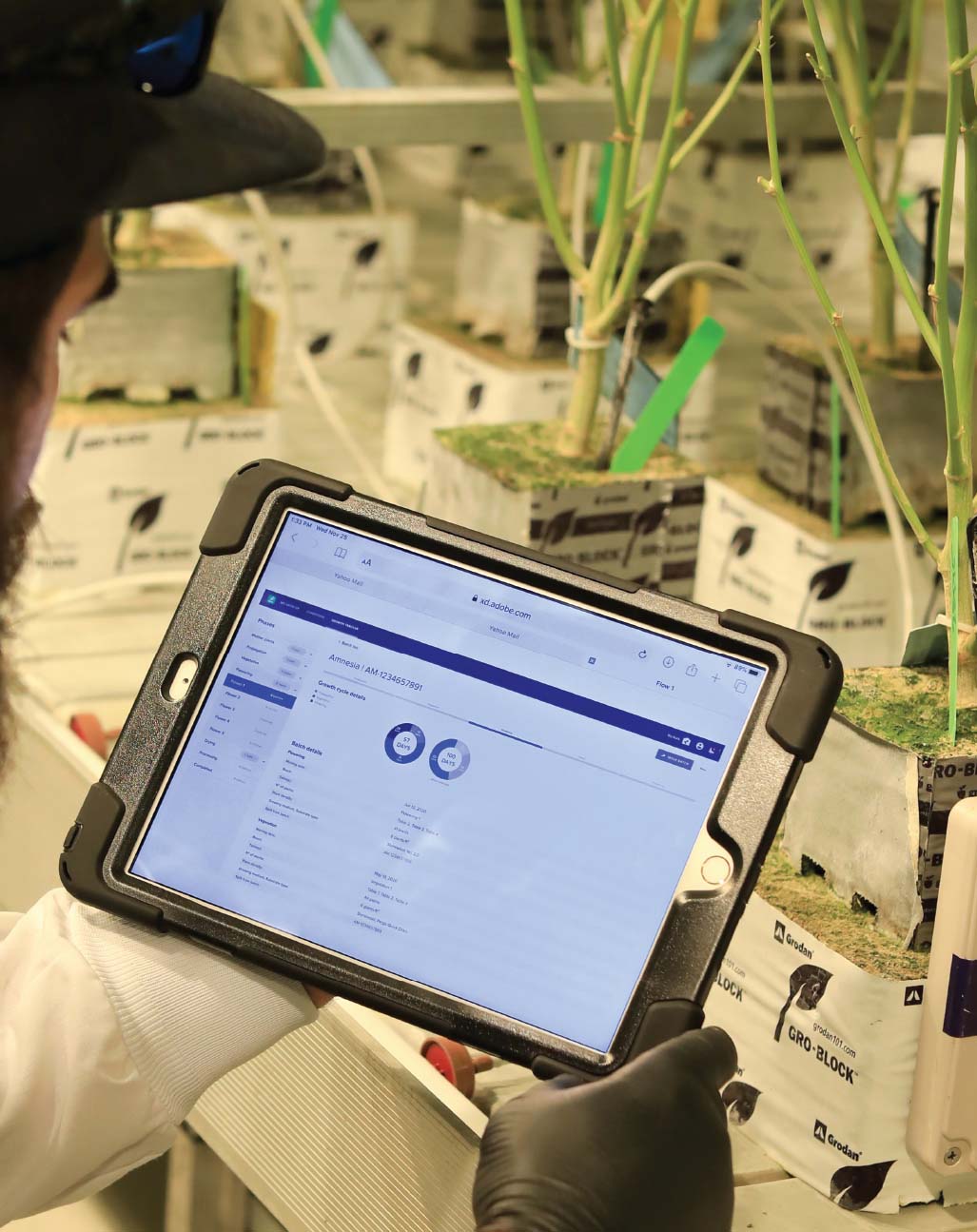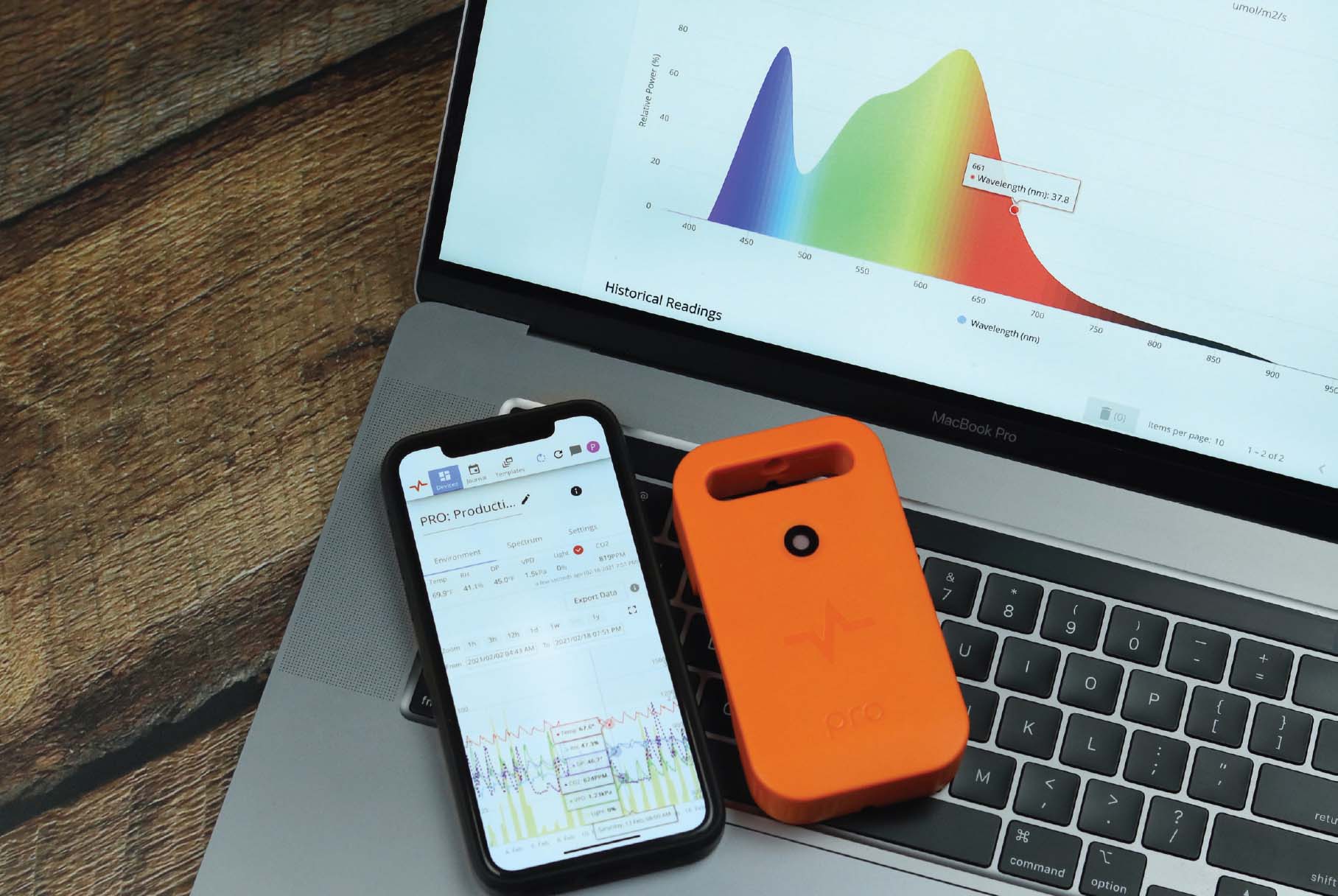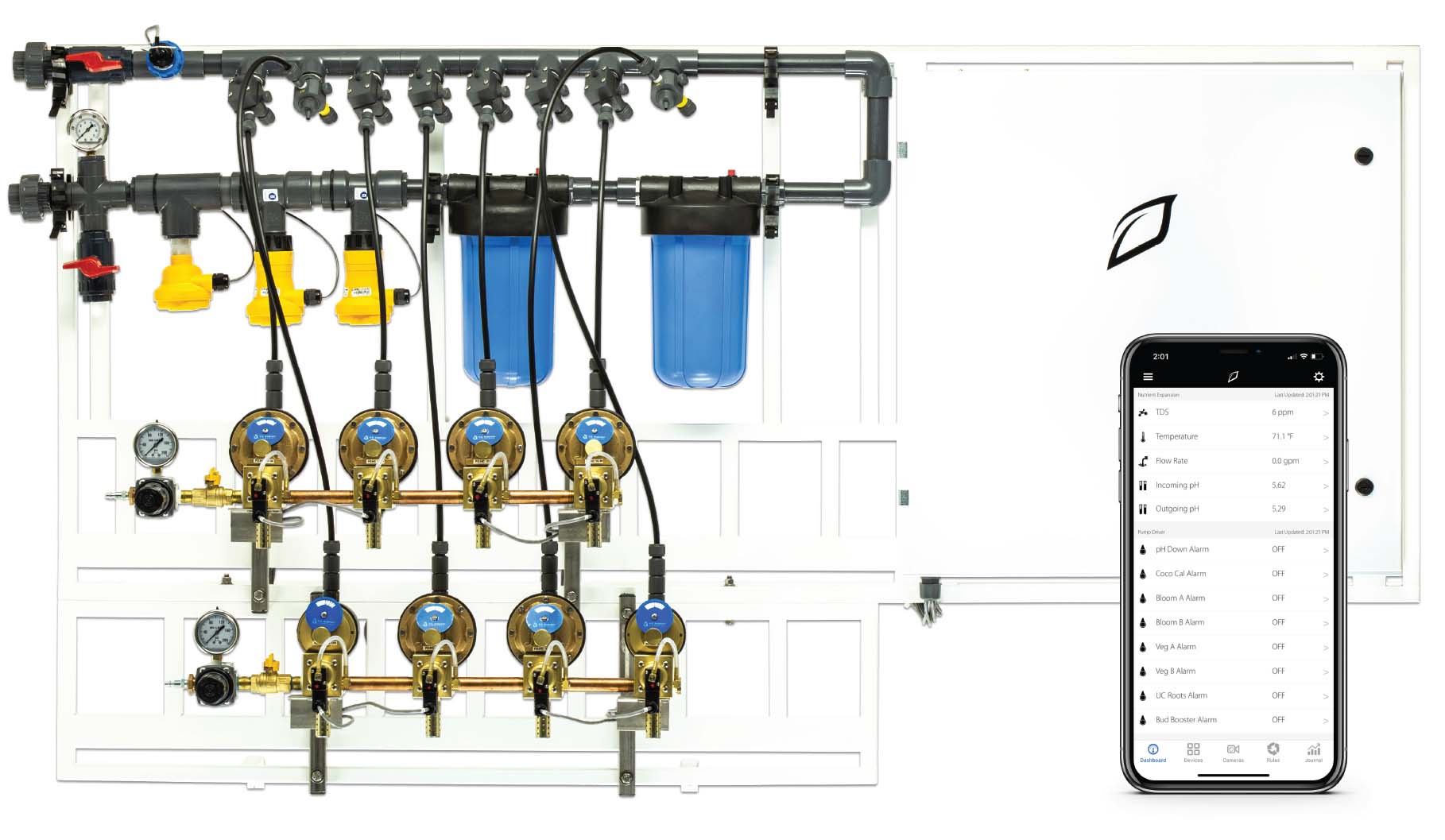
DESIGNING MEDIUM & LARGE SPACES
by Bill Faulconer
Medium-Sized Rooms: Setting Up a 20 x 20 x 8 feet (6 x 6 x 2.4 m) Bloom Room
Equipment
- Lights: (12) LEDs that each provide 1,550 µmol/s or (9) double-ended HPS lights that provide 2,100 µmol/s
- Ratchet pairs: one per light
- Light controller
- High-limit controller
- CO2 supplementation
- CO2 tank and tank controller
- Or CO2 generator and controller
- Strip timer
- Reverse osmosis system if indicated by tests
- 55 gallon (208 l) barrel with float valve
- (2) neoprene light socks (algae black)
If the space will not be ventilated:
- Air conditioning
If the space will be ventilated:
- 1700 cfm charcoal odor filter
- 12 inch (30 cm) 1,700 cfm inline, exhaust fan
Construction
Seams are covered with aluminum tape. The base of the walls is protected using black rubber cover base. This makes regular mopping easier, seals out bugs, eliminates drafts, and traps water, preventing grow room leaks should a flood occur.
Ventilation
Skip this step if the space will not be ventilated.
Toward the right side of this room is an exhaust system designed to ventilate the space. The fan pulls fresh outside air from the opposite side of the room. The system consists of a charcoal filter with a dust sock (sitting on floor), a 12 inch (30 cm) 1700 cfm (48 m3/m) inline fan (sitting on the filter) and a 12 inch duct connection to the ceiling. A replaceable dust filter is installed at the ceiling, and a duct elbow is installed above the ceiling to direct the exhaust toward the exterior vent. The fan is connected to a timer set to run during the dark hours (when CO2 is off) and pulls air out through the charcoal odor filter for about 15 minutes every few hours. The charcoal filter is necessary to avoid exhausting strong odors outside. The fan has a built-in silencer. The main purpose of this system is to provide fresh air periodically, but it can also be used to purge the room after activating bug bombs (when no plants are in the room) or, if necessary, to cool and ventilate the room during air conditioning failure.
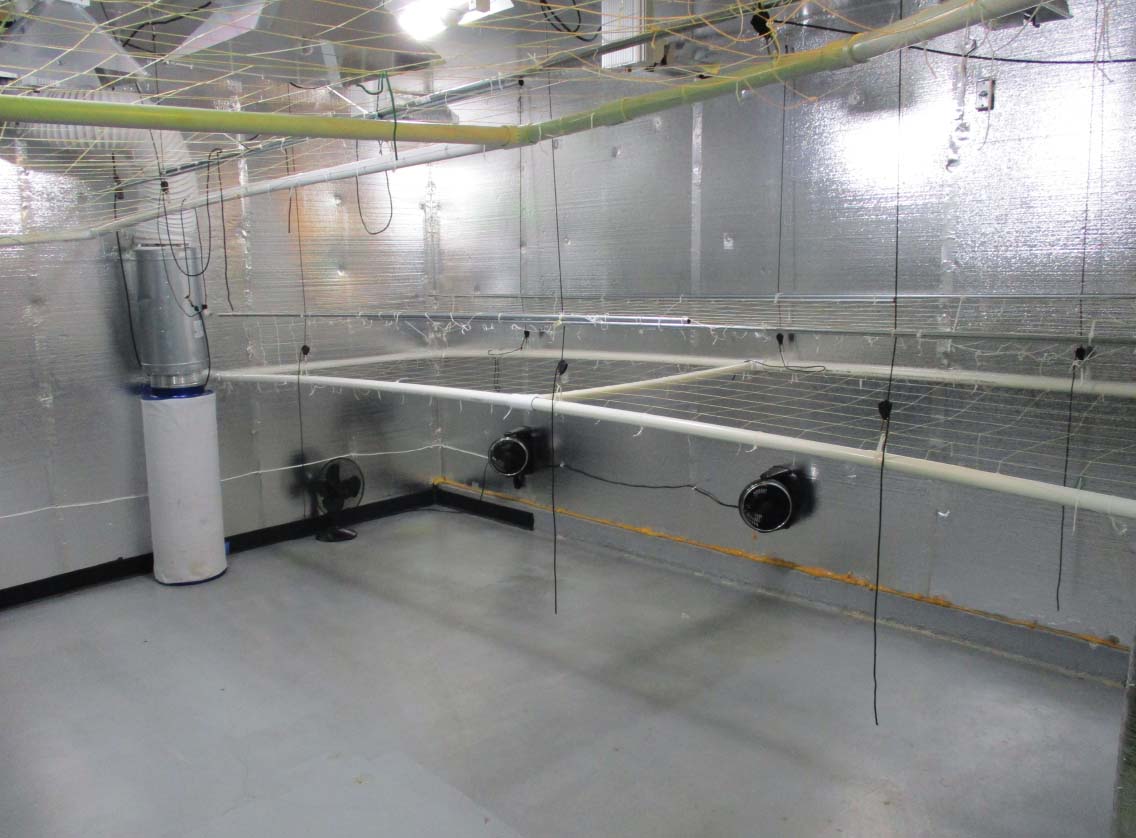
Light, air qualities, and other limiting growth factors should be addressed before moving in plants. Photo: Bill Faulconer
Plant Support
Trellis netting supports plants without installing and removing stakes and tie wire each cycle. In addition to providing support, trellis nets are used to spread the branches to increase light penetration.
A “floating net” trellis designed by the author has the advantage that the front of the net frame can be lifted up while the back is left in place, making it much easier to harvest and replant.
Rather than building legs for a PVC frame at a set height above the floor, the net hangs from ceiling hooks with rope ratchets that are easily raised and lowered. The adjustable height makes it easy to customize for different cultivars. The second layer of netting usually hangs about 10 inches (25 cm) above the first net. Half inch (1.25 cm) electrical aluminum tubing is used because it’s lightweight and inexpensive. The tubing is attached to the ropes, holding up the one and a quarter inch (3 cm) PVC frame with zip ties. Don’t cut the ends off the zip ties and don’t over tighten them. With just enough zip-tie tension, the tubing can be slid up and down and still hold firmly where it is positioned.
Circulation
Circulation refers to how the air moves through the space rather than in and out of it. The mounted wall fans were installed just above the base of plant containers to ensure good air circulation. Note that all cords are securely installed and not lying on the floor or the plants. Good circulation minimizes potential for mold and helps ensure that the temperature, humidity, and CO2 levels are consistent throughout the growing environment. Fans are disabled until the plants are tall enough to have been bottom-pruned to avoid blowing directly on lower leaves. Breathable fabric pots and plastic saucers have been chosen for this garden. Plant roots like to breathe. Movable saucers are easier to move around and clean than large plastic trays. Saucers are also less expensive than larger trays.
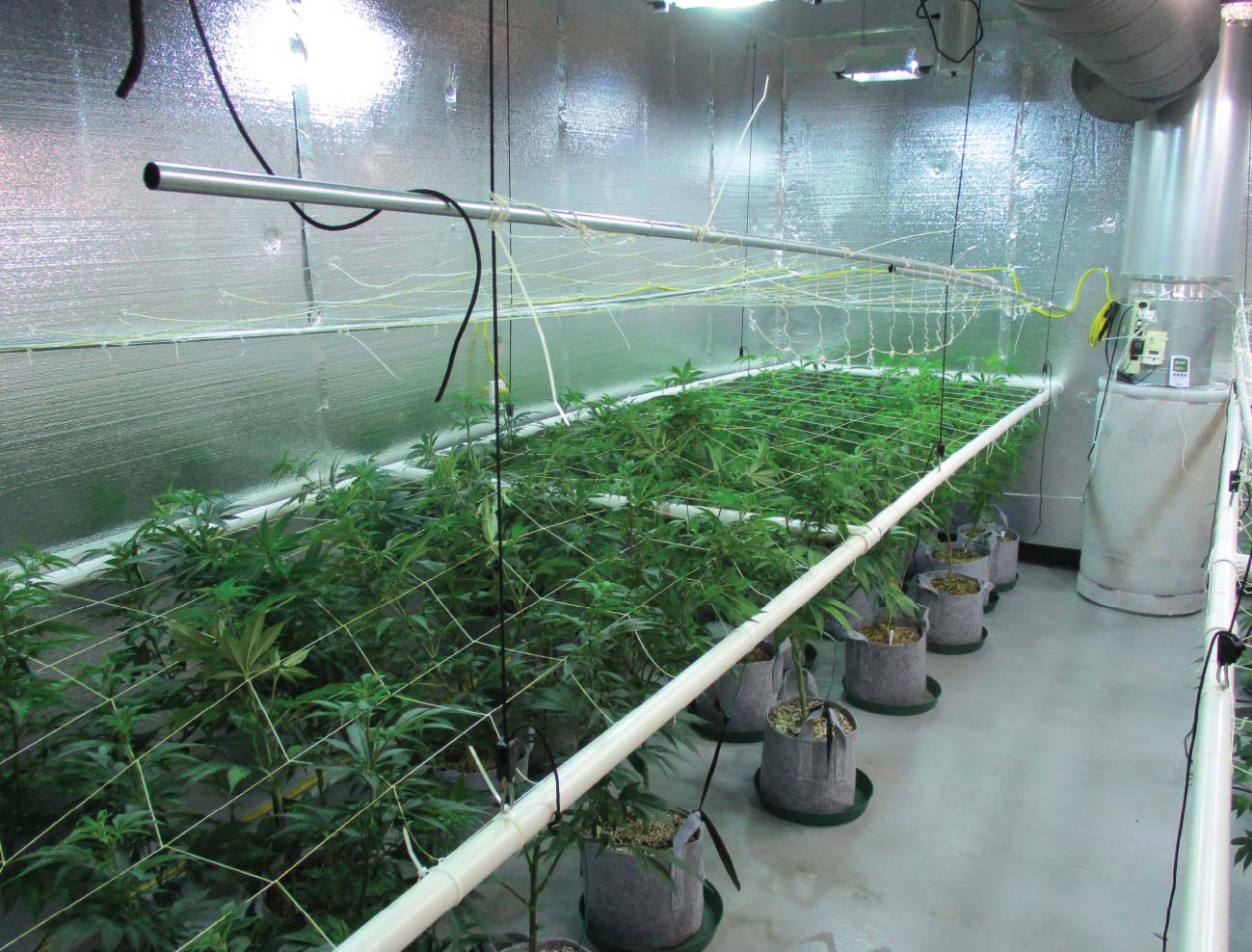
Trellis netting supports plants without installing and removing stakes and tie wire each cycle. Photo: Bill Faulconer
However, using trays or plumbing and tubing, water can be drained automatically while avoiding spills, which are much more likely when using saucers.
Cleaning & Maintenance
A garden can be cleaned and maintained more easily using the right surface materials. Drywall is acceptable, but foam board is mold resistant, has high reflectivity, is easy to install, is lightweight, has a moderate cost, and is easy to clean thoroughly. Polyethylene plastic can be easily installed over other surfaces and can be washed. Epoxy-coated floors are easy to install, incredibly durable, and easy to clean, and they make the whole room seem more like a laboratory.
Air Conditioning
This space is cooled using a four ton (900 kg), 48,000 Btu air conditioner. A frame was built to support the air conditioning unit and to provide a filter frame for the return air being pulled from the room near the floor.
This unit has a quick connect feature, allowing someone who is not an AC technician to install the flexible copper refrigerant lines from the indoor unit to the outdoor unit without having to charge them.
The unit also has a grower-friendly feature called low ambient control. The low ambient feature diminishes or disables the cooling fan on the outdoor unit. Mainstream (as opposed to cannabis horticulture specific) AC units are not designed or warranted for operating in cold temperature. This unit is designed to automatically restart if the power fails and then restores. Mainstream units require a button to be pushed to power them back on after an outage.

All electrical devices are connected through the smart panel and controlled through timers and digital applications.
Control Equipment
For most projects, a painted plywood backboard, usually two by four feet (0.6 x 1.2 meters) is mounted to the wall so that all controls and wire supports can be securely and easily mounted. Half inch (1.25 cm) plywood was installed under the foam board so that anything could be mounted anywhere.
Power wiring from the main electric panel has been installed in flexible conduit. All wires are labeled, and each light is numbered. At the top of the image is an electrical subpanel to distribute power to individual circuit breakers for light controller (45 amps), AC (30 amps), and wall outlets (20 amps). Breakers are labeled.
Lighting
The lighting regimen is managed using a controller. It can accommodate sixteen lights.
The 240 volt power supply enters the bottom of the controller via flexible conduit connected at the other end to a 50 amp, 2-pole, 240 volt circuit breaker in the main panel, using three #8 gauge wires.
No power is provided to the light receptacles until the “trigger cables” receive 120 volts of power from a timer. A high-limit controller is connected between the timer and the light controller to disable lights if the room overheats. A trigger cable controls power to the controller. In an emergency, it can be turned off, eliminating all power to the lights.
High Limit Controls
The wall-mounted device is connected to a timer to activate the lights. This device can avert a costly destruction of the entire crop. The light controller trigger cords are plugged into the controller. The maximum temperature is set so that if the room temperature exceeds 90°F (32°C), due to AC failure or any other cause, the lights are disabled to avoid excessive temperature.
In each room at least one recording thermometer and hygrometer (RH meter) and a surface temperature thermometer aimed at the canopy are used to check plant temperature, rather than just where the display is placed.
Humidity
The humidistat is mounted on the wall, but the humidity sensor is positioned in the canopy to measure humidity in the plant zone. The controller is connected to the ceiling-mounted dehumidifier. Another humidistat controls a humidifier that turns on should the humidity level dip below 55% RH.
CO2
The CO2 controller is connected to a timer or photocell so that the system operates only during the light cycle.
The CO2 tank is plugged into the controller and activated when CO2 levels fall below 1250 ppm during the lit period.
Fuzzy logic is only recommended for CO2 bottle systems as opposed to CO2 generator systems because gas generators cost so little to operate that fuzzy logic is unnecessary and the function simply causes the generator to be ignited too frequently. Aluminum tape was installed over the LCD display to minimize the potential for the display to emit light and disrupt the light cycle during dark hours.
In addition to having a CO2 controller to monitor levels, a second monitor can be useful to check the controller’s accuracy and to check CO2 levels in various areas in the space.
Timers & Timer Strips
There are two wall-mounted strip timers. The top row of four outlets is controlled by the timer, and the bottom row of four outlets is always on. For this project, the light controller and the CO2 controller are connected to timer outlets; the humidity controller, the music box, and wall fans are connected to the hot outlets. Timer strips are handy for eliminating multiple timers, cords, and adapters. The timer is a simple thermostat for control of room temperature.
Drainage
This is an effective drainage system for excess water. The blue tubing on the left is discharge water from the reverse osmosis water purifier runoff. The white tubing in the center is condensate water from the air conditioner. The clear tubing toward the right is condensate water from the dehumidifier mounted above. The black tubing drains to the sewer system and has a P-Trap to prevent sewer gas from entering the room.
Ducting
An innovative fabric duct was selected to supply cooled air into this room. The 16 inch by 20 foot (40 x 60 cm) duct is connected at one end to the air conditioner and is capped at the opposite end. The duct is supported by a steel cable fastened to the ceiling. Moderate bends can be made. The duct clips attach to the steel cable to suspend the entire length. Because the entire length of ducting is perforated along the sides, the cool air is evenly distributed throughout the entire growing space and all the leaves flutter gently. The AC thermostat is set for the blower to be on 24/7 to maximize circulation.
Convenience Lighting
Several ceiling lights (white bulbs) enable the gardener to work in the room (light schedule permitting) without having to turn on the cultivation lights. Working in the garden with thousands of watts of firepower can be unpleasant or unnecessary when pruning, inspecting, spraying, building or taking down a space, or just checking.
Toward the rear of this room is a three-bulb green LED fixture. Green lights provide a working light that can be sparingly used during the “lights off” hours. Without a green light, the bloom cycle is disrupted when lights are turned on during dark hours.
Convenience Light Controls
These old-fashioned yet clever devices prevent serious problems in the garden. Similar to the devices seen in gas station restrooms, these “ticker timers” can be used to turn on white or green convenience lights. In most gardens a wall switch can be accidentally left on, but this does not happen with these ticker timers.
Door Seals
Doors are a notorious source of unwanted light leak, bugs, dust, and contaminants. This door is sealed at the edges with a one inch (2.5 cm) wide and one quarter inch (6 mm) deep felt strip stapled to the door. The door bottom is sealed with a rubber sweep that works like a squeegee and is fastened to the door with screws. To moderate temperatures in the entry room, a vent was installed. The vent is protected with a washable bug screen, and it is protected from light leak with a rooftop rain vent behind the door.
Secure Entry
An entry room or “vestibule” allows the operator to keep unwanted light from entering the bloom room and possibly disrupting the light cycle. It also allows the operator to keep light from escaping and minimizes the potential for contaminants to enter the bloom room.
Nutrient Test Meters
This meter remains in the solution, constantly monitoring the nutrient pH level, temperature, and nutrient strength. The grower can see the levels change as products are added.
Water Purification
A reverse osmosis filter is needed if the source water exceeds 150 ppm dissolved solids (0.6-0.8 EC). Reports are available from the local water company or agency.
Rainwater is a good source because it contains low ppm of minerals. Adjust it to 100-125 ppm prior to adding any supplemental nutrition using CalMag. (See Nutrients & Fertilizers.)
This reverse osmosis purifier can provide up to 150 gallons (568 liters) per day of pure water. The water supply is connected at the pressure gauge. A minimum of 60 psi is needed. Higher pressure results in higher flow. The discharge tubing is connected to a drain.
The purified water is connected to a barrel that has a float valve to stop water flow when the barrel is full. When the inexpensive pre-filters look dirty, they should be replaced. When the purified output exceeds 100 ppm, the costly filter membrane should be replaced.
Water/Nutrient Reservoir
This reservoir barrel is a 55 gallon (208 l) food-grade, high-density polyethylene reservoir. Non-food-grade, low-density polyethylene reservoirs (trash cans) are made from low-density plastics, which degrade and leach petrochemical polymers into the water.
Here the test meter is wall mounted above the reservoir. An air pump is installed outside the reservoir with an air stone inside it to oxygenate and circulate the nutrients.
A submersible water pump in the barrel is connected to a garden hose with a long wand attached to minimize the need to bend over when watering plants. A hose support wheel is mounted above the barrel to store the hose and prevent it from kinking.

Large-scale farms require detailed planning. Every farm is different and requires different considerations for scaling. Photo: Stinkbud
